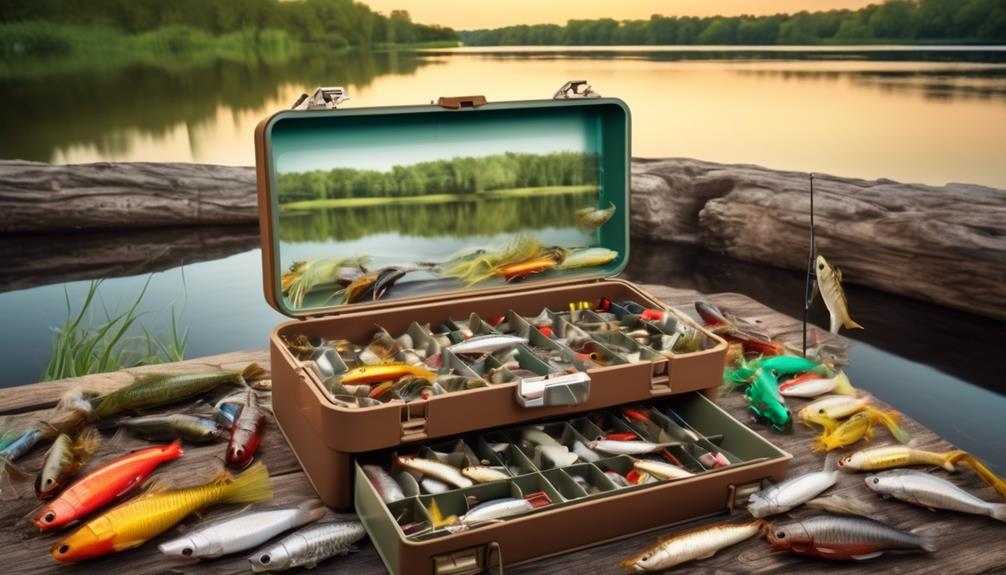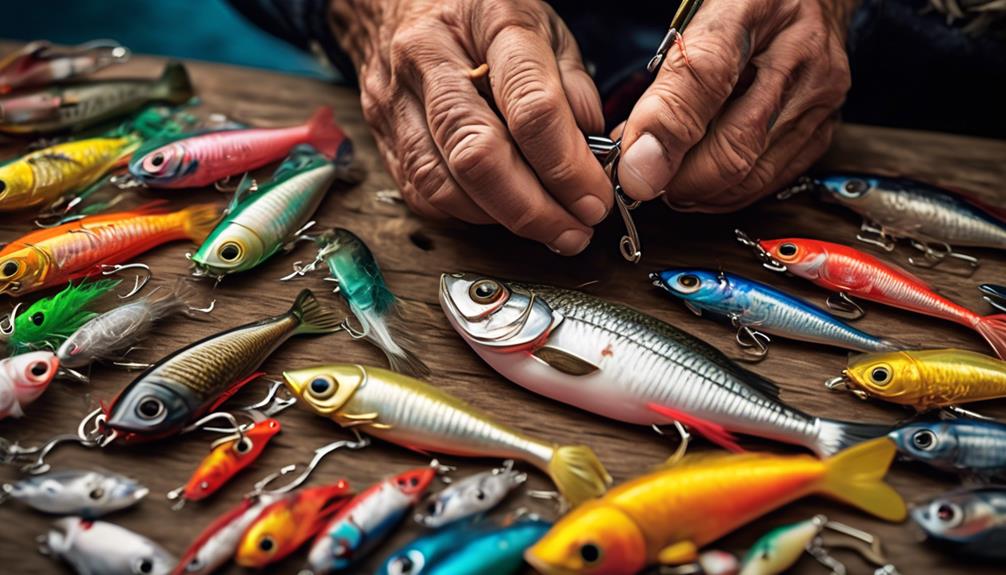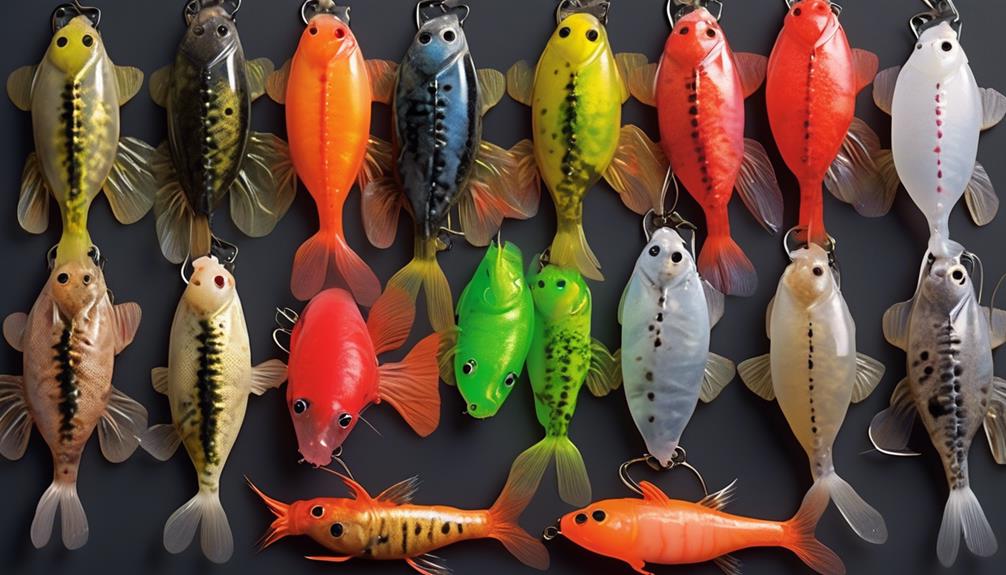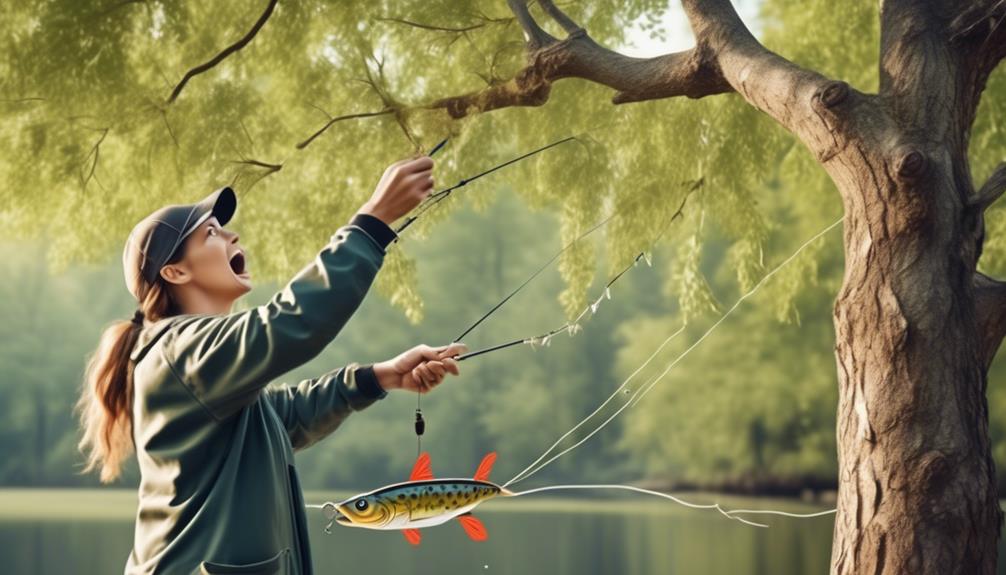Coincidentally, you've found yourself standing on the banks of a river, ready to cast your line and reel in some impressive catches.
But wait, before you make your first cast, have you considered which baits are the most effective for river fishing? Whether you're targeting bass, trout, catfish, or other freshwater species, the right bait can make all the difference.
From live bait options to specialized scented baits, the world of river fishing baits is diverse and intriguing. Stick around to discover the top recommended baits that will have you reeling in the big ones on your next river fishing adventure.
Live Bait Options
When fishing in rivers, using live bait can significantly increase your chances of catching fish. Live bait mimics the natural prey of the fish, making it an enticing option. However, using live bait requires some techniques for preservation and rigging methods to ensure its effectiveness.
Bait preservation techniques are essential to keep your live bait lively and attractive to the fish. One method is to keep the live bait in a well-oxygenated environment. This can be achieved by using a bait bucket or a live well that allows water to flow through, providing a continuous supply of fresh oxygen to the bait. Additionally, keeping the bait at the right temperature is crucial. For example, if you're using minnows, they tend to fare better in cooler water, so having a cooler with ice packs can help maintain their liveliness.
When it comes to live bait rigging methods, there are several options to consider. One popular method is the use of a simple hook and split-shot rig. This involves hooking the live bait (such as a worm or minnow) onto the hook and adding a split-shot weight to help it sink to the desired depth. Another effective rigging method is using a slip bobber rig, which allows you to adjust the depth at which the bait is presented to the fish. This can be particularly useful when fishing in varying water depths.
Mastering bait preservation techniques and live bait rigging methods can greatly enhance your river fishing experience, increasing your chances of reeling in that prized catch.
Artificial Lure Selection
To effectively select artificial lures for river fishing, consider the specific species of fish you're targeting and the prevailing water conditions.
When choosing lure color, opt for bright colors like chartreuse or orange in murky water, and natural hues like green or brown in clear water. For species like bass, bluegill, or trout, matching the color of the lure to the natural prey of the fish can increase your chances of a successful catch.
Additionally, retrieval technique plays a crucial role in attracting fish. Vary your retrieval speed and style to mimic the movement of the prey, such as using a fast and erratic retrieve for predatory fish like pike or slow and steady retrieve for bottom-dwelling species like catfish.
- Lure Color: Consider using bright colors in murky water and natural hues in clear water. Match the color of the lure to the natural prey of the fish for species like bass, bluegill, or trout.
- Retrieval Technique: Vary your retrieval speed and style to mimic the movement of the prey. Use a fast and erratic retrieve for predatory fish like pike and a slow and steady retrieve for bottom-dwelling species like catfish.
- Water Conditions: Adapt the color and retrieval technique based on the prevailing water conditions to effectively attract the targeted fish species.
- Species-Specific Approach: Tailor your lure selection to the specific species of fish you're targeting, as different fish have different preferences for lure color and retrieval techniques.
Best Natural Baits
Consider using a variety of natural baits such as worms, minnows, and crayfish to effectively attract a diverse range of river fish species. When it comes to freshwater bait preferences, different types of fish have varying tastes, and using natural bait allows you to cater to these preferences.
Worms are a classic go-to bait for many river anglers, as they're readily available and attract a wide variety of fish species. You can use them by threading them onto a hook or presenting them on the riverbed to entice bottom-feeding fish.
Minnows are another popular natural bait choice, particularly for predatory fish such as bass and pike. These small fish can be hooked through the lips or tail, allowing them to swim naturally in the water and attract the attention of larger game fish.
Crayfish, on the other hand, are an excellent bait option for catching freshwater species like catfish and smallmouth bass. Their natural movements and scent make them irresistible to these fish, making them a valuable addition to any angler's bait techniques.
When using natural baits, it's essential to consider the presentation. For instance, when using worms, threading them properly onto the hook can make a significant difference in attracting fish. Similarly, understanding the behavior of minnows and crayfish in the water can help you use these baits more effectively.
Effective Soft Plastic Baits
Soft plastic baits offer versatility and effectiveness in enticing river fish to strike, making them a valuable addition to your fishing arsenal. When compared to live bait, soft plastic baits have the advantage of being reusable, durable, and less messy, making them a convenient choice for river fishing.
However, choosing the right artificial lure is crucial for maximizing your success. Here are some tips for selecting the most effective soft plastic baits:
- Consider the Water Conditions: Pay attention to the clarity and depth of the river. In clear water, natural-colored baits like green pumpkin or watermelon can be highly effective. In murky water, opt for brighter colors that can grab the fish's attention.
- Match the Hatch: Observe the natural prey in the river and select soft plastic baits that closely resemble the local forage. This can significantly increase your chances of enticing strikes from the fish.
- Experiment with Different Sizes and Shapes: Vary the size and shape of your soft plastic baits to determine what the fish are responding to on that particular day. Sometimes a subtle change in size or profile can make a big difference.
- Utilize Scented Baits: Consider using soft plastic baits that are infused with fish-attracting scents. This can help mask any unnatural odors and make the bait more enticing to the fish.
Top Hard Baits for Rivers
When targeting river fish with artificial lures, the versatility and effectiveness of hard baits offer a compelling alternative to soft plastic options.
Two top hard baits for river fishing are spinnerbaits and crankbaits.
Spinnerbaits are versatile lures that can be used in various river fishing techniques. You can employ spinnerbait techniques such as slow-rolling, bulging, or burning to entice river fish like bass, pike, or walleye. These baits work well in rivers due to their ability to cover a lot of water and attract fish in varied water conditions.
Crankbaits are another popular hard bait choice for river fishing. They come in various shapes and sizes, each designed to reach different depths. When fishing in rivers, it's essential to understand crankbait depth variations. Depending on the river's depth and current, you can choose a shallow, medium, or deep diving crankbait to effectively target different species of river fish. The erratic action and lifelike swimming motion of crankbaits make them irresistible to predatory fish in river environments.
Fly Fishing Bait Choices
One effective bait choice for fly fishing in rivers is the dry fly, which imitates insects that land on the water's surface. This bait is particularly effective when fish are actively feeding on the surface.
However, there are other bait choices to consider when fly fishing in rivers. Here are some recommendations for fly fishing bait choices:
- Streamside Fly Patterns: When choosing fly fishing bait for river fishing, it's important to consider the types of insects that are prevalent in the area. Streamside fly patterns, such as caddis flies, mayflies, and stoneflies, can be incredibly effective as they mimic the insects that fish are naturally feeding on.
- Nymph Fishing Techniques: Nymphs are aquatic insect larvae that are a staple food source for many fish in rivers. Nymph fishing involves using imitations of these aquatic insects, which are fished below the water's surface. Utilizing nymph fishing techniques can be highly productive, especially when fish aren't actively feeding on the surface.
- Wet Flies: Wet flies are designed to sink below the water's surface, making them an excellent choice for fishing in deeper or faster-moving water. These flies can imitate various aquatic insects and are often used when fish are feeding below the surface.
- Emergers: Emerger flies imitate insects that are transitioning from aquatic nymphs to fully fledged adult insects. These flies are designed to be fished just below the surface and can be highly effective when fish are selectively feeding on emerging insects.
Innovative Homemade Baits
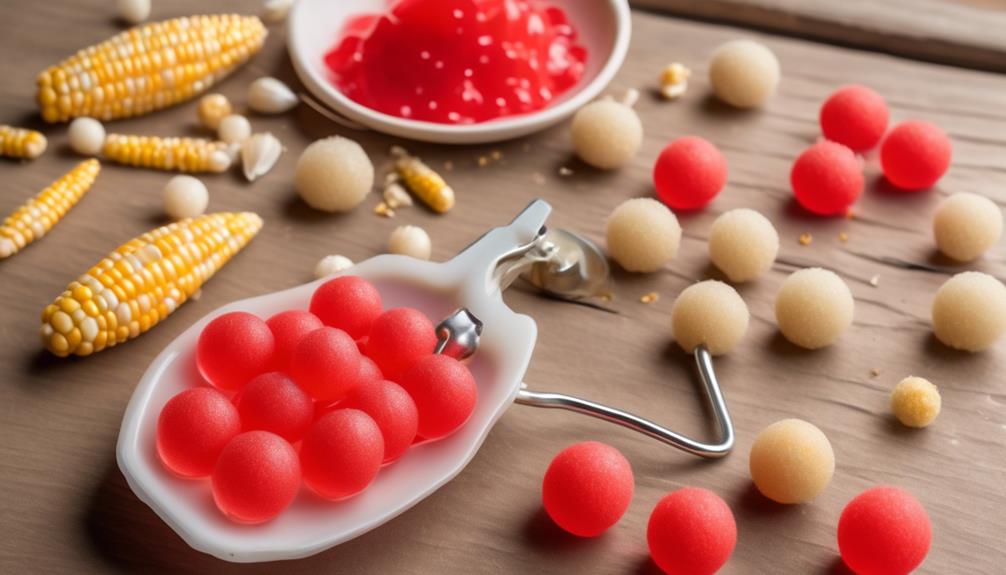
Create your own homemade baits using natural ingredients and innovative techniques to attract fish in river fishing. DIY bait recipes can be both effective and fun to make.
One unique bait design involves using cheese as a base. Mix shredded cheese with flour and water to create a dough-like consistency. Add a drop of anise oil for extra scent, then form the mixture into small balls. This bait works well for catfish and carp due to its strong smell and soft texture.
Another innovative homemade bait involves using jello powder. Mix your desired flavor of jello powder with hot water until it dissolves, then add in some corn syrup and flour to form a thick paste. Mold the paste into small cubes or balls and let it cool and harden. This colorful and sweet-smelling bait can attract trout and panfish.
For a more natural approach, try making bait using insects. Crickets, grasshoppers, and mealworms can be blended with flour, cornmeal, and water to form a paste. This bait is particularly effective for catching bass and bluegill.
Innovative homemade baits allow you to experiment with different ingredients and scents, giving you the opportunity to customize your bait to suit the specific fish species in the river you're fishing. Get creative and try out various DIY bait recipes to see which ones work best for your fishing adventures.
Specialized Scented Baits
To enhance your river fishing experience, consider using specialized scented baits designed to attract specific fish species. Scented baits offer several benefits that can increase your chances of a successful fishing trip. They can attract fish from a distance, mask human odors that might repel fish, and stimulate a fish's natural feeding response.
If you're interested in using specialized scented baits, here are some alternatives and techniques to consider:
- Dough Baits: These baits are infused with strong scents like garlic, cheese, or anise, which can be particularly effective for catching catfish and carp in rivers.
- Liquid Attractants: Applying liquid attractants to your bait can enhance its scent and make it more appealing to a wider range of fish species. It's a versatile option that can be used with various types of bait.
- Biodegradable Baits: Environmentally conscious anglers may prefer biodegradable scented baits, which are designed to break down naturally and minimize environmental impact.
- Slow-Release Baits: Some specialized scented baits are formulated to release scent slowly over time, creating a long-lasting attractant trail in the water to lure in fish.
When using specialized scented baits, it's important to apply the scent properly to the bait. For example, if you're using a dough bait, kneading it thoroughly to distribute the scent evenly can improve its effectiveness. Additionally, consider the water temperature and current when applying scents, as these factors can affect how far the scent travels and dissipates.
Frequently Asked Questions
How Important Is It to Match the Bait to the Specific Fish Species in the River?
When river fishing, matching bait to the specific fish species is crucial. The importance of bait selection can't be overstated. Using the right bait can significantly impact your success.
Different fish species have unique preferences, and understanding this is key to effective river fishing techniques. Matching bait to the fish species in the river increases your chances of a successful catch and makes your fishing experience more rewarding.
Are There Any Regulations or Restrictions on Using Certain Types of Bait in Different River Locations?
When fishing in different river locations, regulations and restrictions on bait use can vary.
It's essential to check local laws and guidelines to ensure compliance.
Some areas may have restrictions on live bait or specific types of artificial bait.
Always research and follow the regulations in the river locations you plan to fish in to avoid any legal issues and help preserve the environment.
What Are Some Common Mistakes Anglers Make When Choosing Bait for River Fishing?
When picking bait for river fishing, some common mistakes anglers make with bait selection include:
- Using the wrong type for the specific fish species.
- Ignoring the natural prey in the area.
- Overlooking the impact of water conditions.
It's essential to consider:
- The fish you're targeting.
- The environment.
- The behavior of the prey.
Avoid these errors by:
- Researching the local ecosystem.
- Adapting your bait choice accordingly.
This will increase your chances of having a successful fishing trip.
How Can Weather and Water Conditions Affect the Effectiveness of Different Baits?
When it comes to river fishing, weather and water conditions play a big role in bait effectiveness. Temperature and water clarity can greatly impact which bait will work best for you. Additionally, river currents also affect your bait selection.
Understanding how these factors influence the behavior of fish can help you choose the right bait for the conditions you're facing. It's important to consider these variables to improve your chances of a successful fishing trip.
Are There Any Special Techniques or Tips for Using Live Bait in River Fishing?
When river fishing, using live bait requires some special techniques. To increase your chances of success, consider the bait selection strategies that suit the specific weather and water conditions. Adjust your approach based on the bait effectiveness in the environment.
Keep in mind that river fishing techniques can vary, so experiment with different methods to find what works best for you. Pay attention to the movement of the water and adapt your live bait presentation accordingly.
Conclusion
So, whether you prefer live bait, artificial lures, natural baits, soft plastics, hard baits, fly fishing, homemade options, or scented baits, there are plenty of effective choices for river fishing.
It's important to consider the specific conditions of the river and the type of fish you're targeting when selecting your bait.
With the right bait and a little bit of patience, you'll be reeling in some impressive catches in no time.
Happy fishing!
